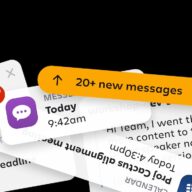5-second summary
- time management strategies are specific frameworks or systems to maximize your time and energy
- we’ve gathered four time management strategies that put you in the driver’s seat of your tasks, schedule, time, and energy, each in a different way.
- take our one-minute quiz to find out which strategy will be the biggest difference-maker for you.
on any given workday, your objective might feel pretty straightforward: ride heroically into that daily battle with your to-do list and live to see tomorrow.
but we should all think bigger than “get a bunch of stuff done.” don’t just settle for some minimum number of tasks crossed off your list – aim for getting the right things accomplished, without ending your day feeling depleted.
that’s where time management strategies come into play. these models go beyond the war with your to-do list, helping you execute meaningful work in an efficient and fulfilling way.
how do time management strategies help?
time management strategies are specific frameworks or systems to maximize your time and energy. put another way, they help you overcome several common time management roadblocks.
- multitasking: research shows that the human brain is incapable of doing more than one thing at once (unless you count autonomous tasks like breathing). when you think you’re multitasking, you’re actually context switching – rapidly jumping between various tasks. while it might make you feel like you’re dominating your to-do list, this constant switching of gears is a drag on your 世界杯欧洲预选赛直播平台 . time management strategies help you stop juggling and start focusing.
- fires and emergencies: you know the feeling. your intentions for your workday are quickly sidetracked by the latest three-alarm emergency that lands in your inbox. while time management strategies won’t keep these red alerts off your desk entirely, they will help you better discern what actually deserves your immediate attention, rather than continuing to play inbox whack-a-mole.
- information overload: meetings. emails. notifications. calls. documents. requests. day in and day out, you’re inundated with information. that cognitive overload (which is what happens when the volume or complexity of incoming information exceeds your ability to absorb it) causes us to be less effective by seeking out low-value tasks, overlooking important details, and overall just feeling stuck. the right time management strategy can help you filter through the relentless noise to find your starting point.
- energy depletion: everything we’ve already mentioned – from the last-minute requests to the relentless information avalanche – quickly drains your tank. time management strategies allow you to be more mindful of not only your time but also your energy levels. with the right approach in your toolbox, you’ll be better equipped to schedule work more strategically and avoid running yourself ragged.
there are plenty of hurdles that time management strategies will get you over, but they’re not a fix-all. if you’re struggling with an unmanageable workload, bona fide burnout, or other mental health problems, the right time management hack probably isn’t your answer. those more complex issues require conversations with your company leadership and/or a trusted mental health professional.
the fundamentals: 5 time management best practices that always hold water
there are several specific techniques you can use to make better use of your work hours – we’ll get to those in a minute). regardless of which one you try, there are a few general time management best practices that are always a good idea – and a good place to start.
- prioritize: well-executed time management is rooted in focusing on your most meaningful and important work – but first, you need to parse out the meaningful from the mundane. strategically ordering your work based on criteria like impact, deadlines, and effort required serves as a good foundation for any time management strategy.
- schedule breaks: even the most productive people need adequate time to rest and recharge. no time management system should be synonymous with constant, dogged work. your brain quite literally needs breaks – brain activity research says so.
- limit distractions: no time management system will make a major impact if you’re consistently waylaid by pings, pushes, and drop-bys. try your best to minimize distractions, especially during times when you’re doing deep work.
- get organized: searching for what you need isn’t the most efficient use of your time. get a decent organization system in place so that, when you’re ready to work, you can jump right in. time management tools can help you tame the chaos, but make sure you don’t pile on too many or you’ll over-complicate your workflows.
- understand your peaks and valleys: you know you best, so think about how your energy tends to ebb and flow throughout the workday. maybe you have a pep in your step first thing in the morning, but the two hours after lunch are a major slog. paying attention to when you’re most focused and energized will help you make the most of those energetic hours, like saving your morning for deep work and cleaning out your inbox after lunch.
4 time management strategies to maximize your time and energy
now that you’re schooled on the basics, let’s take a look at four widely used time management frameworks.
1. eisenhower matrix
what it is: a four-quadrant chart that helps you categorize all your tasks based on their urgency and their importance or impact
how it works: draw a square and separate it into four even quadrants. along the y-axis, label those boxes with “important” and “not important.” on the top x-axis, label those boxes with “urgent” and “not urgent.”

next, categorize each task on your to-do list. is that slide deck important and urgent? it goes in the top left box. is your expense report not important but urgent? it goes in the bottom left box. once everything is sorted, you can approach each category like this:
- urgent and important: do these first!
- urgent and not important: delegate these if you can. otherwise, tackle them next.
- not urgent and important: schedule time for these in the coming weeks.
- not urgent and not important: these can fall off your to-do list entirely.
also called a “prioritization matrix,” this handy tool helps you filter through a lengthy task list and pull out the items that require your immediate attention.
2. 80/20 rule
what it is: a principle positing that 80% of your results come from only 20% of your efforts.
how it works: since time management is about getting the most meaningful work done, this strategy (also called the pareto principle) focuses on finding the highest-impact tasks on your list – with the idea that those will generate the biggest outcomes for your workday.
you’ll likely be drawn to the low-hanging fruit and quick wins on your to-do list, but this guiding principle forces you to look at your tasks through a new lens: which ones will have the biggest impact?
cleaning up your inbox probably won’t lead to a substantial result. however, compiling all the data that another team has been waiting on for days will.
3. time blocking
what it is: a method that involves splitting your day into segments of time and dedicating each one to a specific task.
how it works: remember when you were in school and you knew what to expect during every moment of your day? at 11am you’re in chemistry class, at noon you have lunch, and so on.
time blocking is a lot like that. you’ll create blocks of time on your calendar and assign certain tasks or groups of tasks to that specific spot on your schedule.
for example, maybe you’ll address your emails from 8am to 9am, meet with the design team from 9am to 9:30am, and draft copy for a project from 9:30am to 11:30am.
it might feel overly prescriptive or rigid. but this level of detail helps you take a more proactive approach to your workday, rather than letting emails, requests, and other people control your entire schedule.
4. pomodoro technique
what it is: a strategy that breaks your workday into smaller chunks of time (usually 25 minutes) separated by five-minute breaks.
how it works: your workday might feel daunting, but you could likely do pretty much anything if you knew it’d only take 25 minutes, right?
that’s the concept behind the pomodoro technique. the gist is that you’ll set a timer and work for a period of 25 minutes. when the timer goes off, you take a five-minute break. after doing that cycle (called a “pomodoro”) four times, you take a longer break of about 20 minutes.
it’s helpful for a few reasons. for starters, it can amp up your focus by instilling a greater sense of urgency. most of us are naturally competitive, so you’ll likely challenge yourself to get as much done as you can in that 25-minute chunk before your timer goes off.
plus, the pomodoro technique has built-in breaks. as counterintuitive as it seems, those regular opportunities to step away can give a major boost to your energy and 世界杯欧洲预选赛直播平台 .
which time management strategy should you try?
these four time management strategies put you in the driver’s seat of your tasks, schedule, time, and energy, each in a different way. but that doesn’t mean you should roll out all of them at once.
you’ll see better results if you pick one. not sure how to figure out which one will be the biggest difference-maker for you? this one-minute quiz will point you in the right direction.
once you know which time management strategy is best suited to you and your goals, test it out and see if it makes a noticeable difference. if it’s the right fit, you shouldn’t just get more done – you should feel more fulfilled and energized by what you’ve accomplished.









































